TOYOTA RAV4 2009 XA30 / 3.G Owners Manual
Manufacturer: TOYOTA, Model Year: 2009, Model line: RAV4, Model: TOYOTA RAV4 2009 XA30 / 3.GPages: 516, PDF Size: 10.61 MB
Page 431 of 516
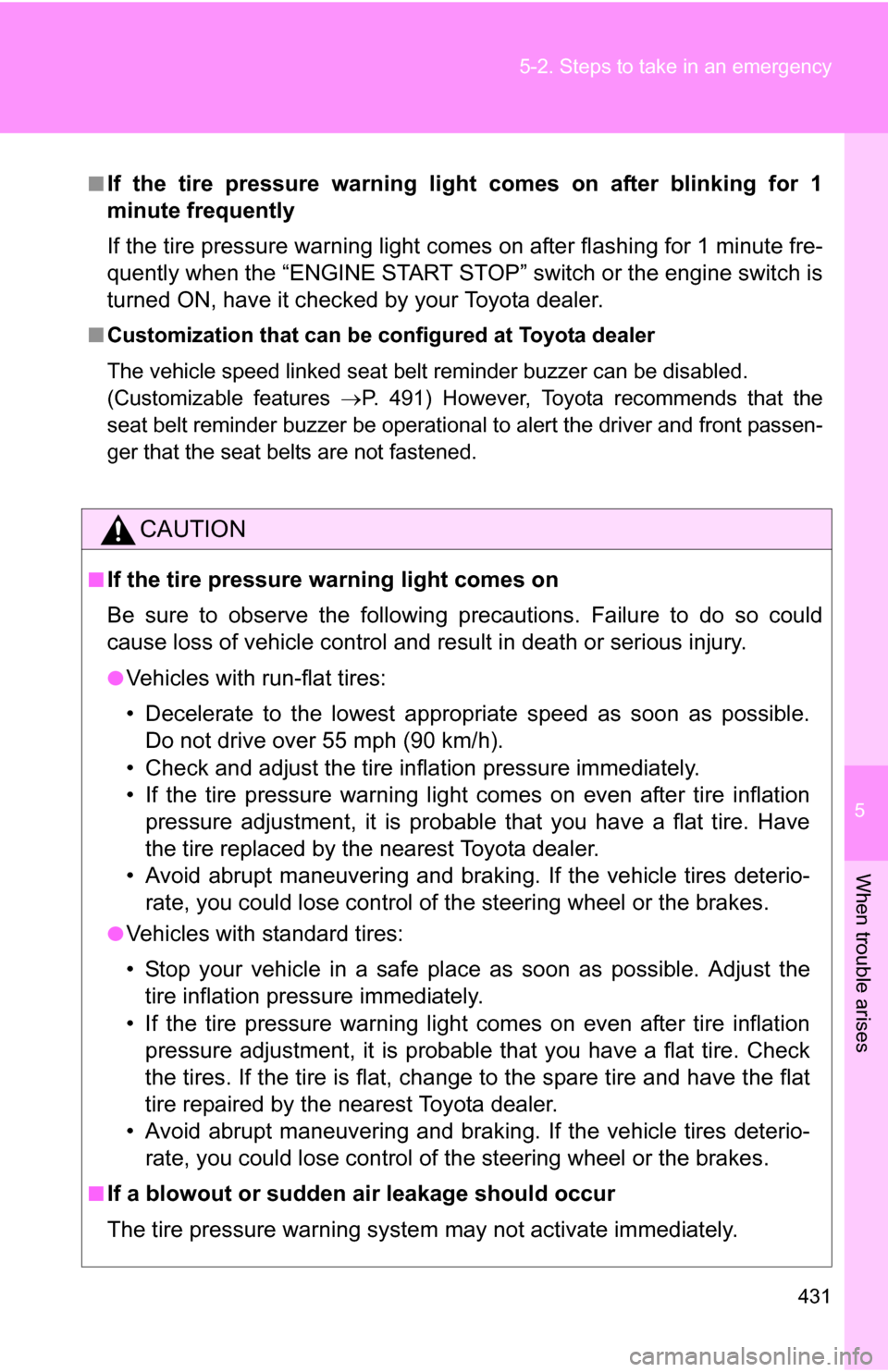
5
When trouble arises
431
5-2. Steps to take in an emergency
■If the tire pressure warning light comes on after blinking for 1
minute frequently
If the tire pressure warning light comes on after flashing for 1 minute fre-
quently when the “ENGINE START STOP” switch or the engine switch is
turned ON, have it checked by your Toyota dealer.
■
Customization that can be co nfigured at Toyota dealer
The vehicle speed linked seat belt reminder buzzer can be disabled.
(Customizable features P. 491) However, Toyota recommends that the
seat belt reminder buzzer be operational to alert the driver and front passen-
ger that the seat belts are not fastened.
CAUTION
■If the tire pressure warning light comes on
Be sure to observe the following precautions. Failure to do so could
cause loss of vehicle control and result in death or serious injury.
●Vehicles with run-flat tires:
• Decelerate to the lowest appropr iate speed as soon as possible.
Do not drive over 55 mph (90 km/h).
• Check and adjust the tire inflation pressure immediately.
• If the tire pressure warning light comes on even after tire inflation pressure adjustment, it is probable that you have a flat tire. Have
the tire replaced by the nearest Toyota dealer.
• Avoid abrupt maneuvering and brak ing. If the vehicle tires deterio-
rate, you could lose control of th e steering wheel or the brakes.
●Vehicles with standard tires:
• Stop your vehicle in a safe place as soon as possible. Adjust the
tire inflation pressure immediately.
• If the tire pressure warning light comes on even after tire inflation pressure adjustment, it is probable that you have a flat tire. Check
the tires. If the tire is flat, change to the spare tire and have the flat
tire repaired by the nearest Toyota dealer.
• Avoid abrupt maneuvering and brak ing. If the vehicle tires deterio-
rate, you could lose control of th e steering wheel or the brakes.
■If a blowout or sudden air leakage should occur
The tire pressure warning system may not activate immediately.
Page 432 of 516
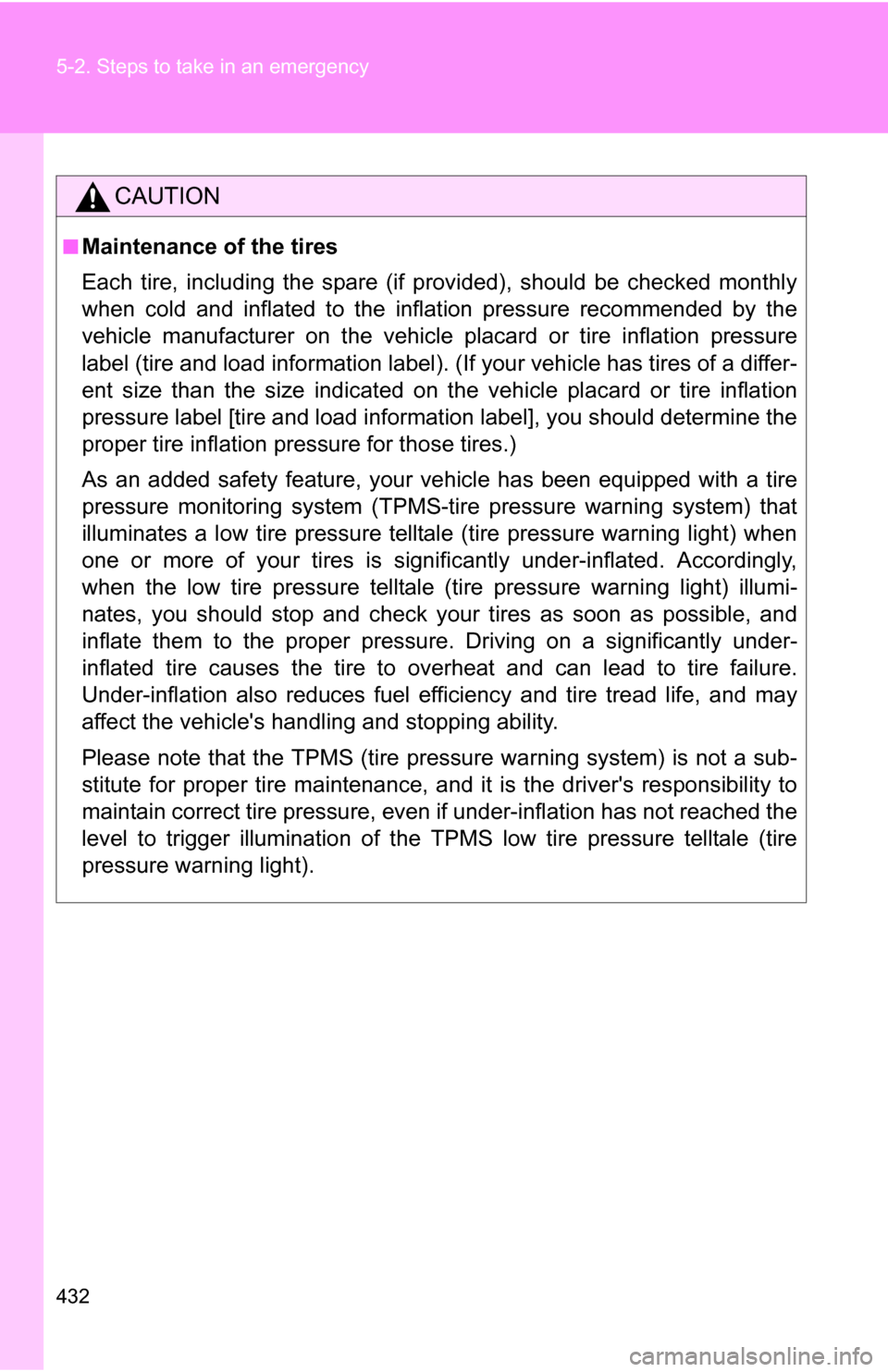
432 5-2. Steps to take in an emergency
CAUTION
■Maintenance of the tires
Each tire, including the spare (if provided), should be checked monthly
when cold and inflated to the inflation pressure recommended by the
vehicle manufacturer on the vehicle placard or tire inflation pressure
label (tire and load information label). (If your vehicle has tires of a differ-
ent size than the size indicated on the vehicle placard or tire inflation
pressure label [tire and load information label], you should determine the
proper tire inflation pr essure for those tires.)
As an added safety feature, your vehicle has been equipped with a tire
pressure monitoring system (TPMS-ti re pressure warning system) that
illuminates a low tire pressure telltal e (tire pressure warning light) when
one or more of your tires is significantly under-inflated. Accordingly,
when the low tire pressu re telltale (tire pressure warning light) illumi-
nates, you should stop and check your tires as soon as possible, and
inflate them to the proper pressure. Driving on a significantly under-
inflated tire causes the tire to overheat and can lead to tire failure.
Under-inflation also reduces fuel effi ciency and tire tread life, and may
affect the vehicle's hand ling and stopping ability.
Please note that the TPMS (tire pressure warning system) is not a sub-
stitute for proper ti re maintenance, an d it is the driver's responsibility to
maintain correct tire pressure, even if under-inflation has not reached the
level to trigger illu mination of the TPMS low tire pressure telltale (tire
pressure warning light).
Page 433 of 516
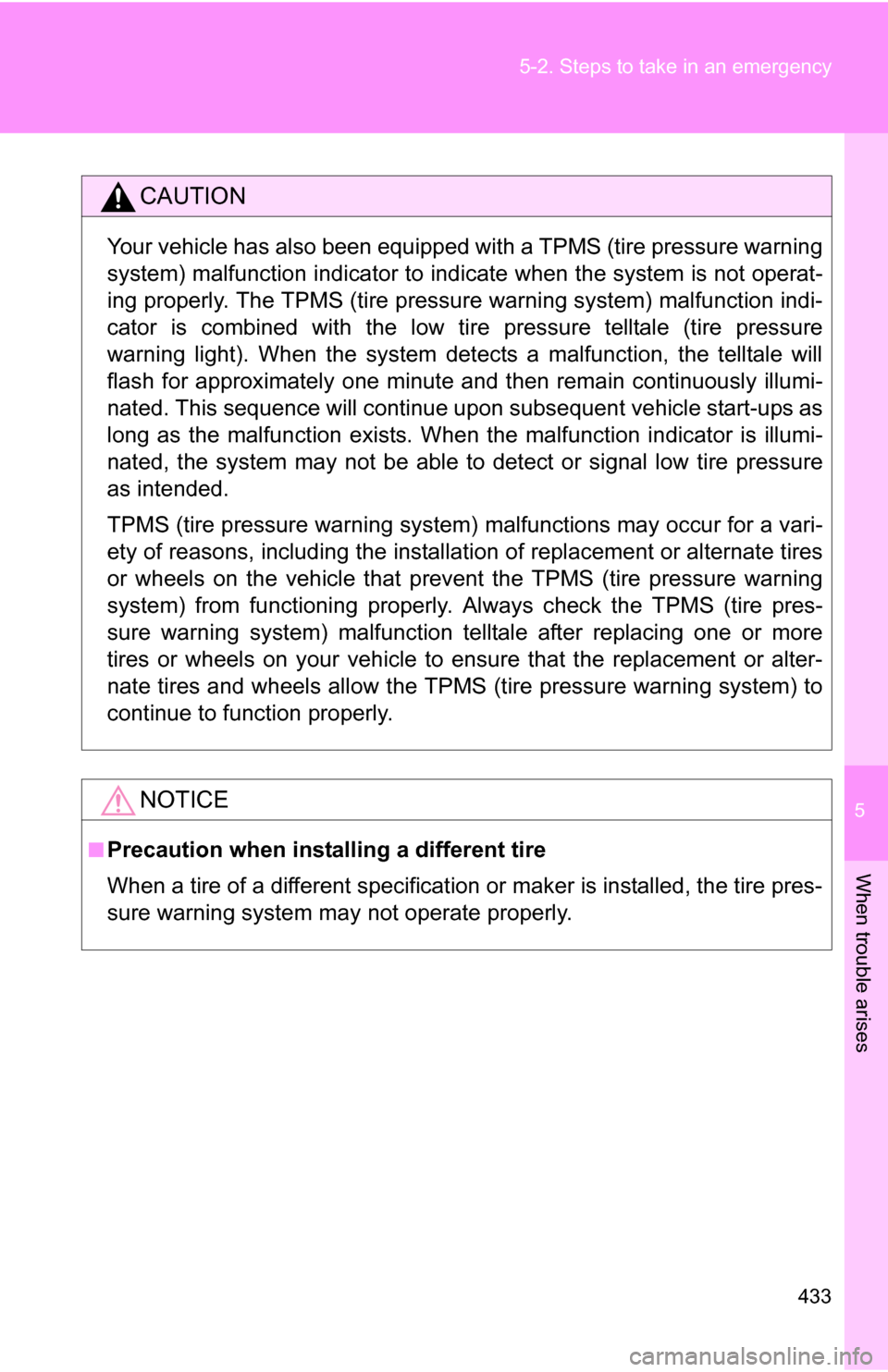
5
When trouble arises
433
5-2. Steps to take in an emergency
CAUTION
Your vehicle has also been equipped with a TPMS (tire pressure warning
system) malfunction indicator to indi
cate when the system is not operat-
ing properly. The TPMS (tire pressure warning system) malfunction indi-
cator is combined with the low tire pressure telltale (tire pressure
warning light). When the system det ects a malfunction, the telltale will
flash for approximately one minute an d then remain continuously illumi-
nated. This sequence will continue upon subsequent vehicle start-ups as
long as the malfunction exists. When the malfunction indi cator is illumi-
nated, the system may not be able to detect or signal low tire pressure
as intended.
TPMS (tire pressure warning system) malfunctions may occur for a vari-
ety of reasons, including the installati on of replacement or alternate tires
or wheels on the vehicle that prevent the TPMS (tire pressure warning
system) from functioning properly. Always check the TPMS (tire pres-
sure warning system) malfunction te lltale after replacing one or more
tires or wheels on your vehicle to ensure that the replacement or alter-
nate tires and wheels allow the TPMS (tire pressure warning system) to
continue to function properly.
NOTICE
■Precaution when installing a different tire
When a tire of a different specification or maker is installed, the tire pres-
sure warning system may not operate properly.
Page 434 of 516
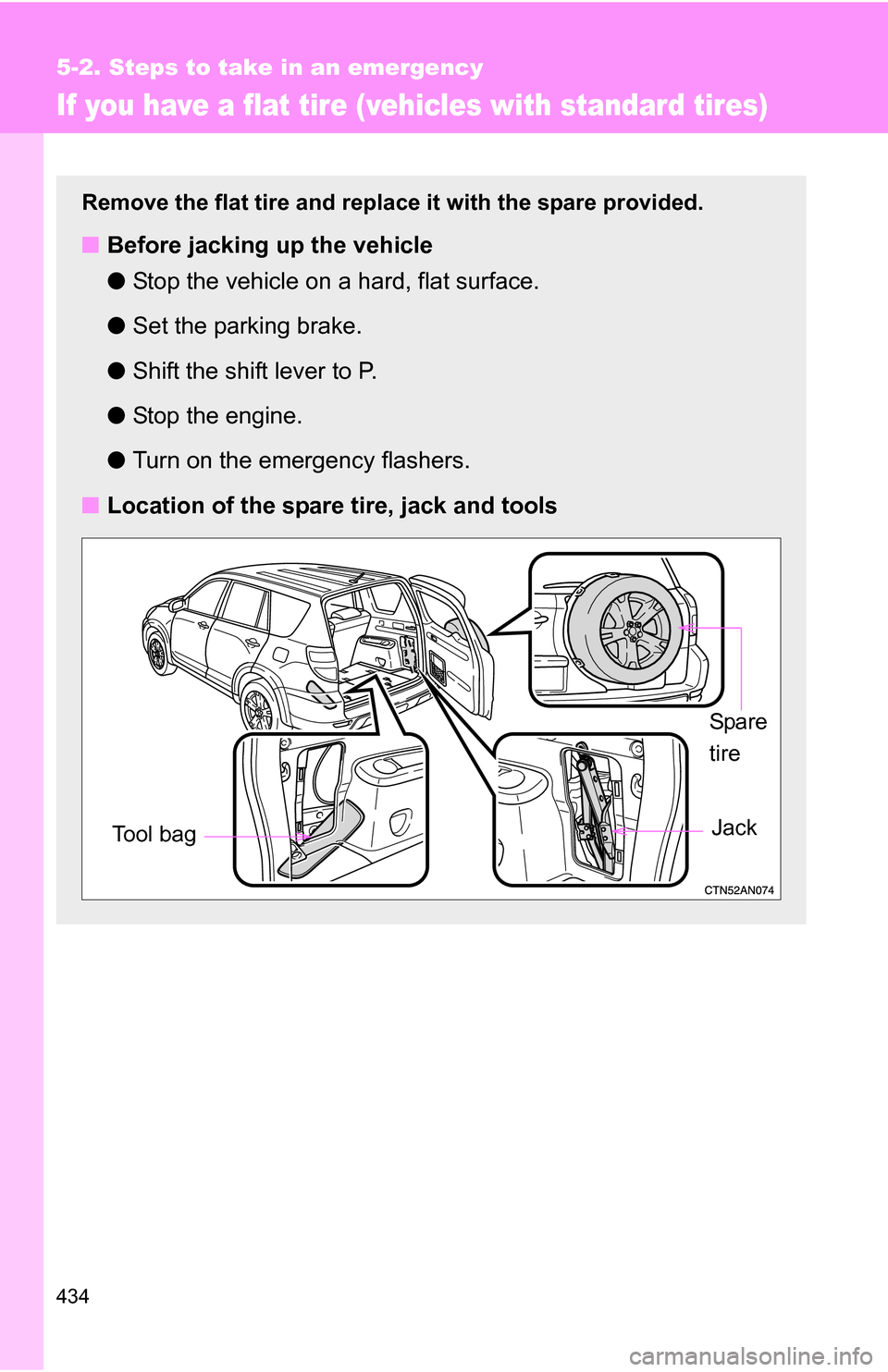
434
5-2. Steps to take in an emergency
If you have a flat tire (vehicles with standard tires)
Remove the flat tire and replace it with the spare provided.
■Before jacking up the vehicle
●Stop the vehicle on a hard, flat surface.
● Set the parking brake.
● Shift the shift lever to P.
● Stop the engine.
● Turn on the emergency flashers.
■ Location of the spare tire, jack and tools
Spa re
tire
Tool bag
Jack
Page 435 of 516
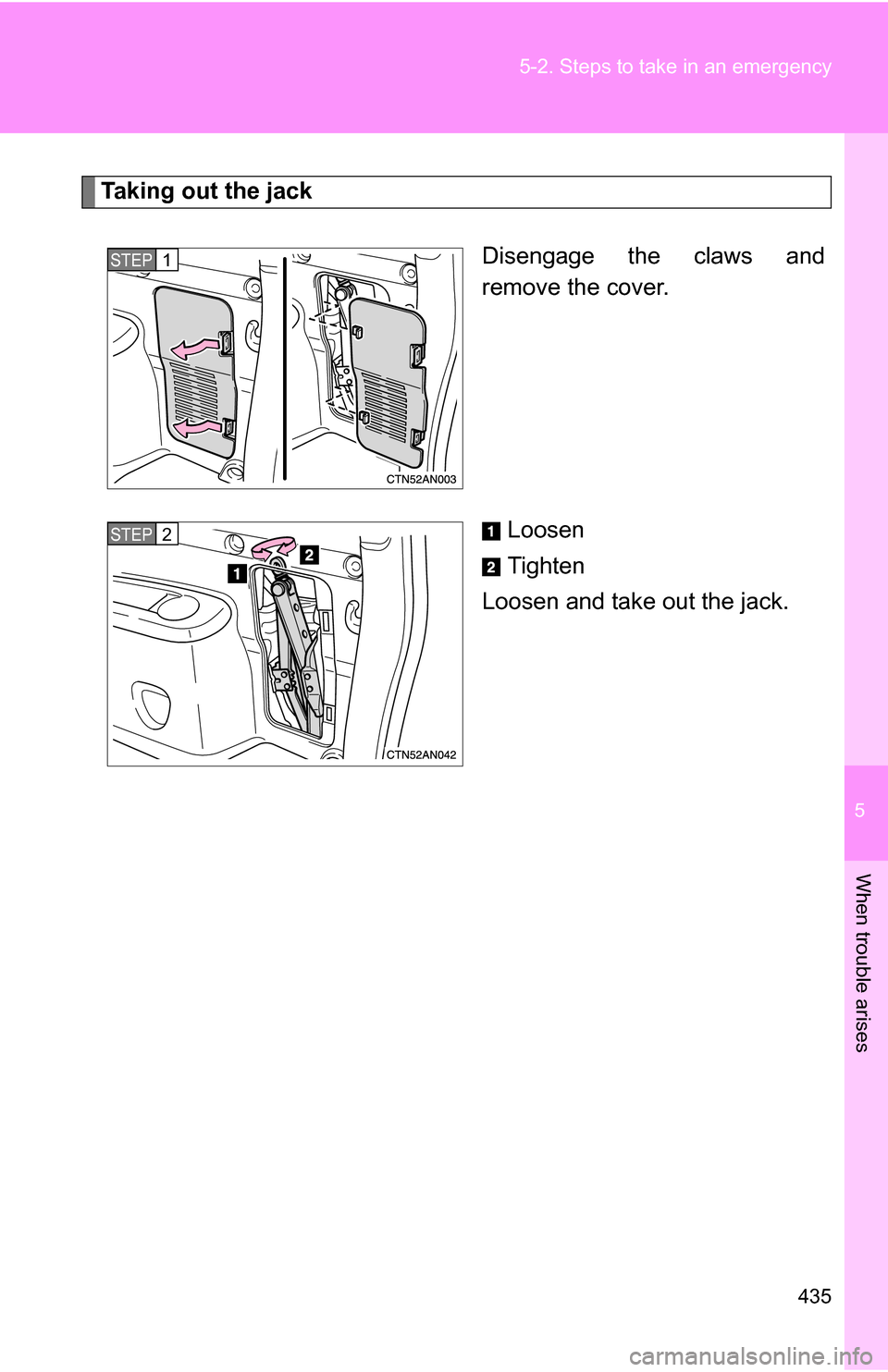
5
When trouble arises
435
5-2. Steps to take in an emergency
Taking out the jack
Disengage the claws and
remove the cover.
Loosen
Tighten
Loosen and take out the jack.
STEP 1
STEP 2
Page 436 of 516
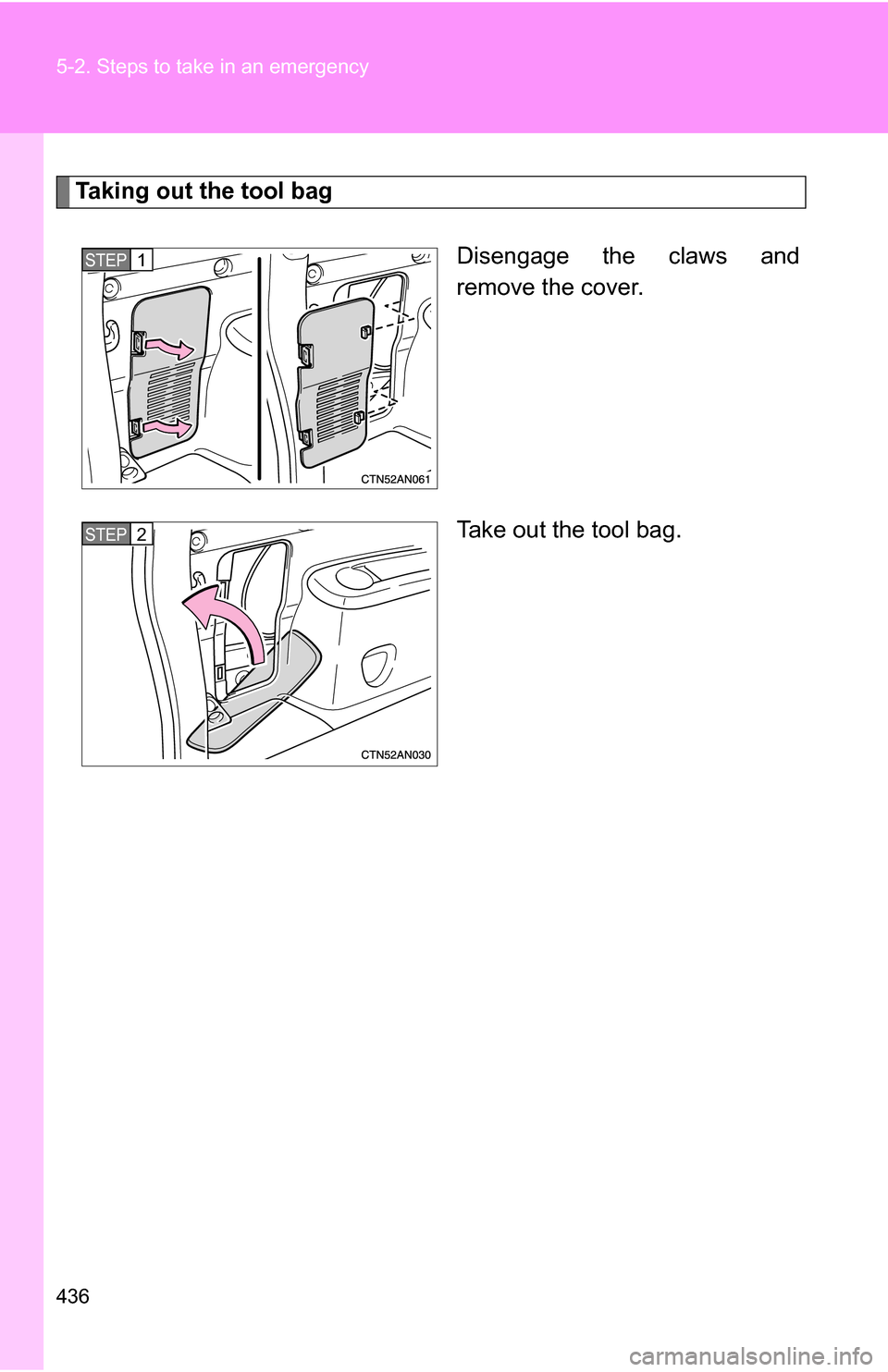
436 5-2. Steps to take in an emergency
Taking out the tool bagDisengage the claws and
remove the cover.
Take out the tool bag.
STEP 1
STEP 2
Page 437 of 516
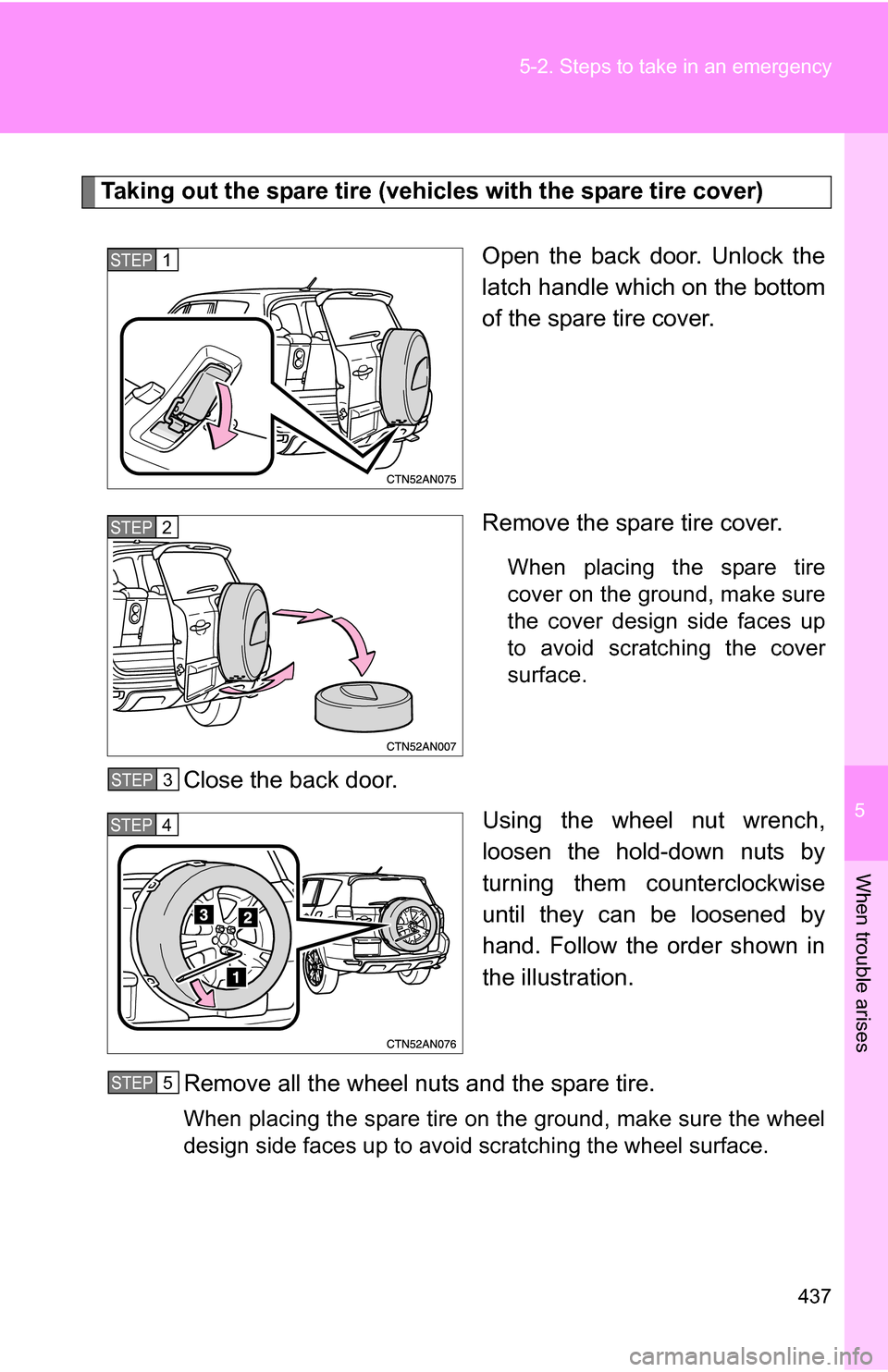
5
When trouble arises
437
5-2. Steps to take in an emergency
Taking out the spare tire (vehicles with the spare tire cover)
Open the back door. Unlock the
latch handle which on the bottom
of the spare tire cover.
Remove the spare tire cover.
When placing the spare tire
cover on the ground, make sure
the cover design side faces up
to avoid scratching the cover
surface.
Close the back door.Using the wheel nut wrench,
loosen the hold-down nuts by
turning them counterclockwise
until they can be loosened by
hand. Follow the order shown in
the illustration.
Remove all the wheel nuts and the spare tire.
When placing the spare tire on the ground, make sure the wheel
design side faces up to avoid scratching the wheel surface.
STEP 1
STEP 2
STEP 3
STEP 4
STEP 5
Page 438 of 516
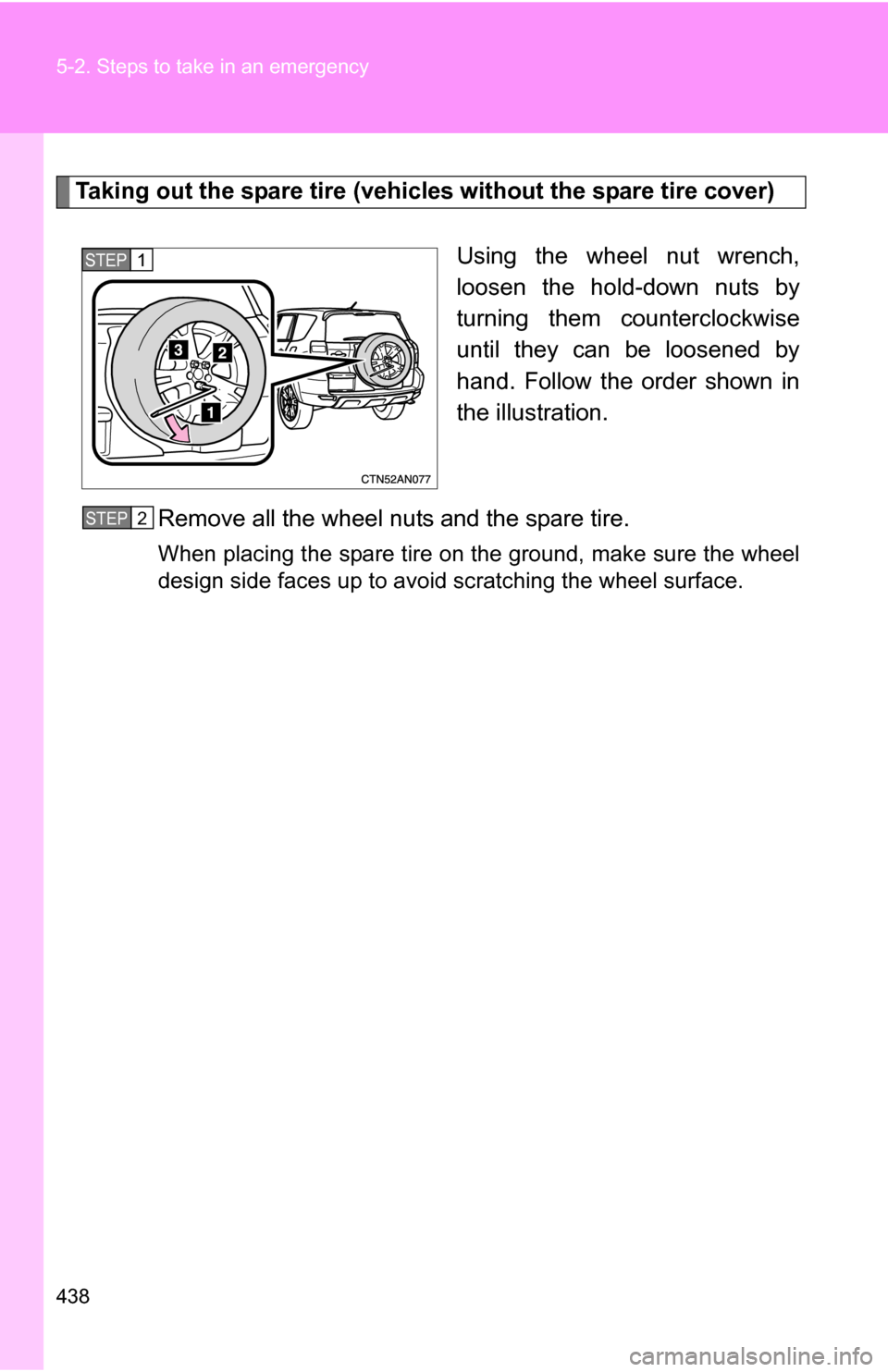
438 5-2. Steps to take in an emergency
Taking out the spare tire (vehicles without the spare tire cover) Using the wheel nut wrench,
loosen the hold-down nuts by
turning them counterclockwise
until they can be loosened by
hand. Follow the order shown in
the illustration.
Remove all the wheel nuts and the spare tire.
When placing the spare tire on the ground, make sure the wheel
design side faces up to avoid scratching the wheel surface.
STEP 1
STEP 2
Page 439 of 516
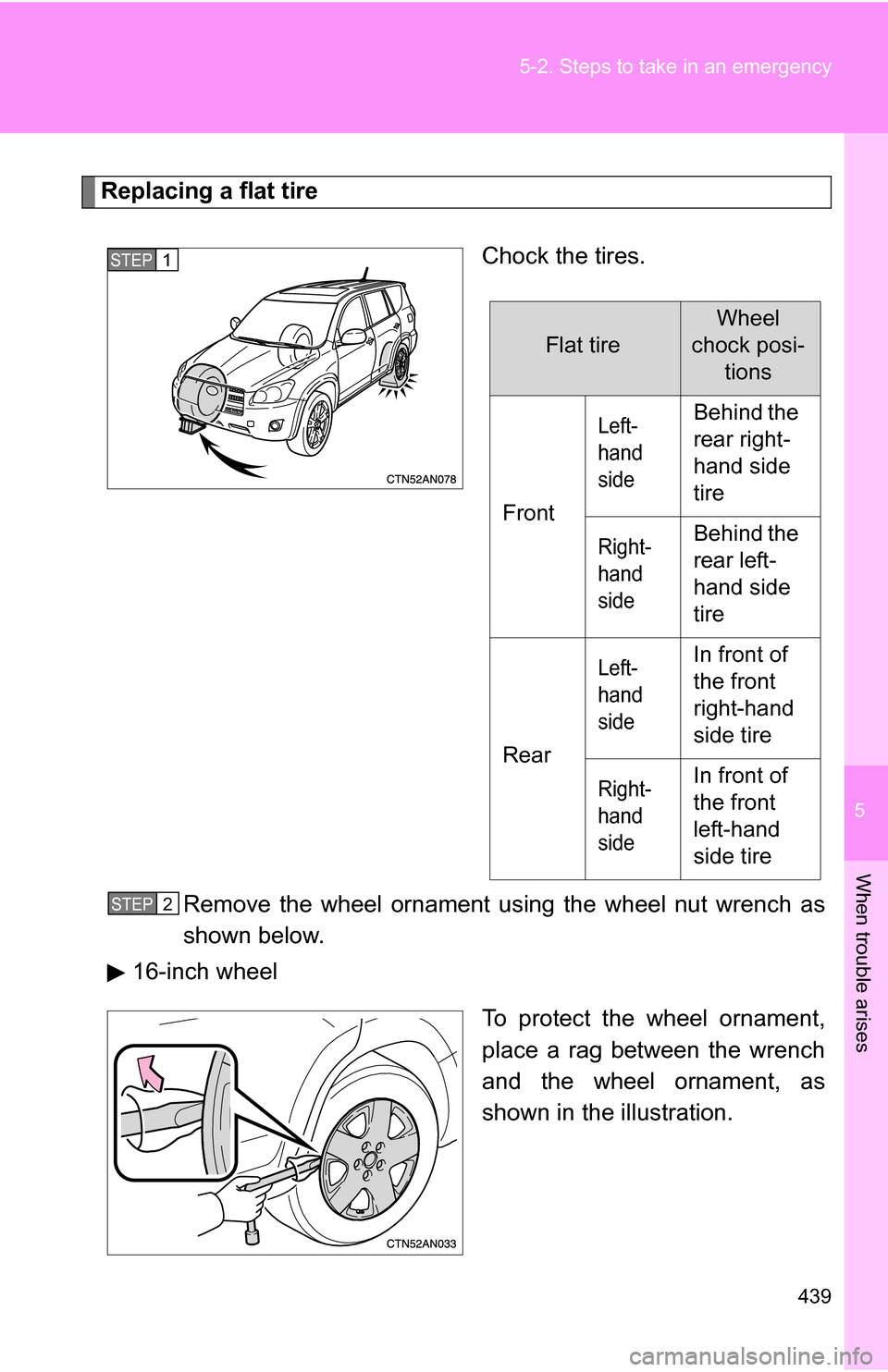
5
When trouble arises
439
5-2. Steps to take in an emergency
Replacing a flat tire
Chock the tires.
Remove the wheel ornament using the wheel nut wrench as
shown below.
16-inch wheel
To protect the wheel ornament,
place a rag between the wrench
and the wheel ornament, as
shown in the illustration.
STEP 1
Flat tire
Wheel
chock posi- tions
Front
Left-
hand
sideBehind the
rear right-
hand side
tire
Right-
hand
sideBehind the
rear left-
hand side
tire
Rear
Left-
hand
sideIn front of
the front
right-hand
side tire
Right-
hand
sideIn front of
the front
left-hand
side tire
STEP 2
Page 440 of 516
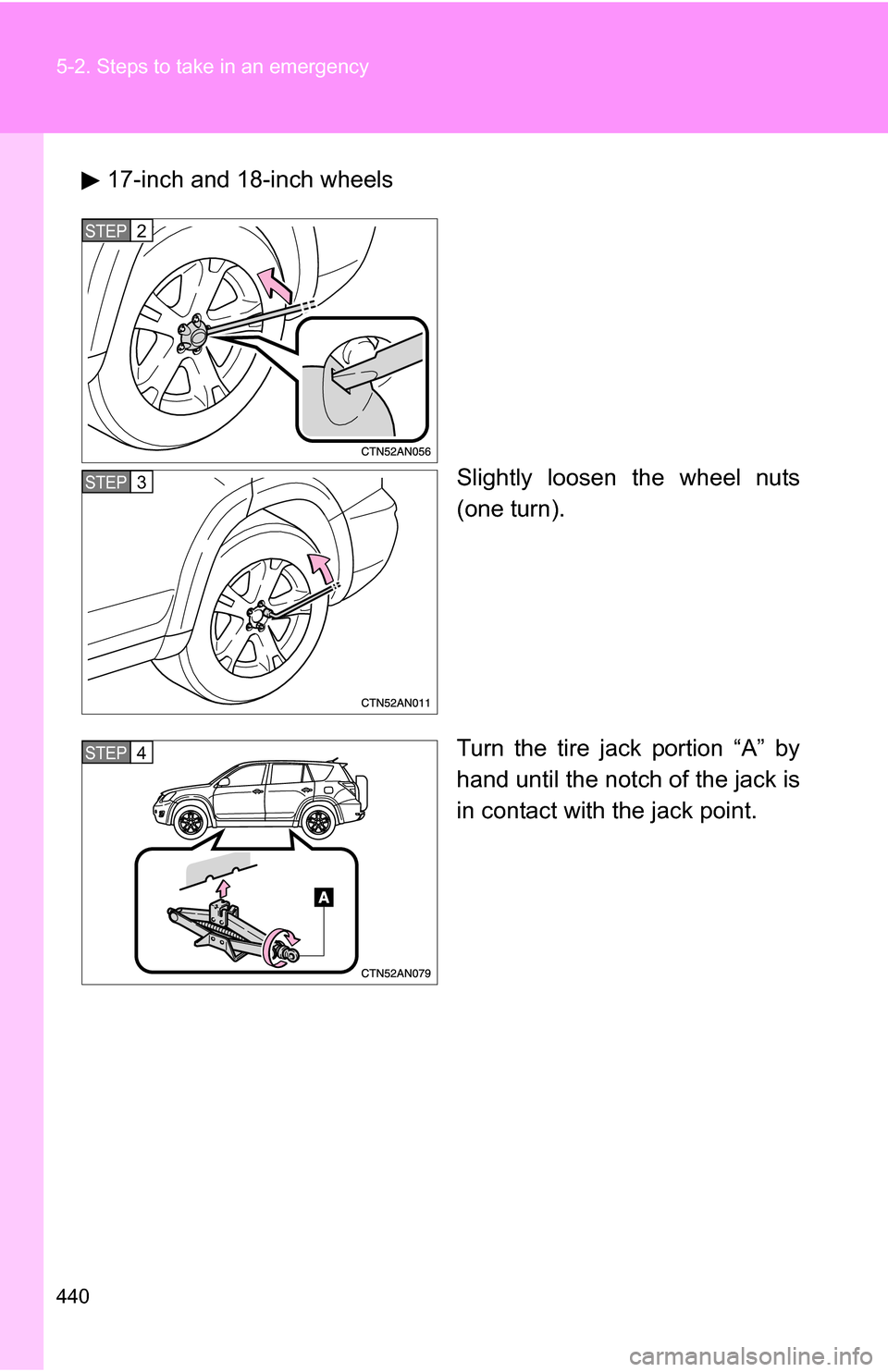
440 5-2. Steps to take in an emergency
17-inch and 18-inch wheelsSlightly loosen the wheel nuts
(one turn).
Turn the tire jack portion “A” by
hand until the notch of the jack is
in contact with the jack point.
STEP 2
STEP 3
STEP 4